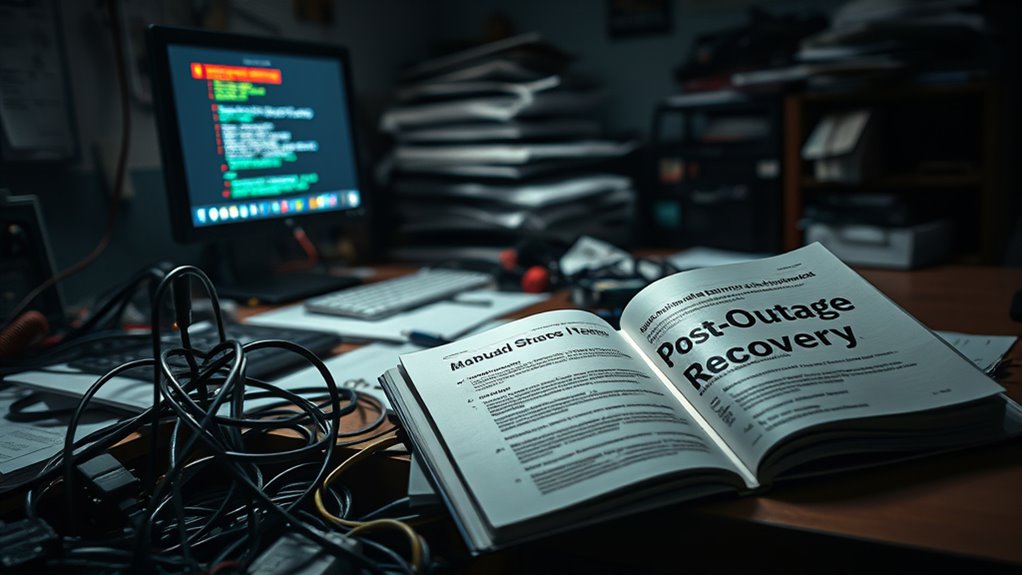Post-outage recovery costs go beyond immediate repairs, including hidden expenses like reputational damage, regulatory fines, employee productivity loss, and legal liabilities. These costs can silently drain resources and extend recovery time if not carefully managed. To minimize these hidden impacts, you need a solid checklist that covers proactive planning, failure assessment, and resilience strategies. Keep exploring to discover actionable steps that can help you avoid costly surprises and strengthen your recovery efforts.
Key Takeaways
- Inadequate planning can lead to overlooked expenses like overtime, repairs, and lost productivity during recovery efforts.
- Failing to assess reputational damage post-outage can result in long-term customer loyalty and trust costs.
- Not documenting recovery processes increases legal and compliance risks, causing hidden fines and penalties.
- Poor failure assessment may cause unnecessary or prolonged interventions, escalating recovery expenses.
- Neglecting proactive resilience measures can lead to higher recovery costs, extended downtime, and overlooked operational impacts.
Understanding the True Financial Impact of Downtime

Understanding the true financial impact of downtime requires looking beyond just the immediate loss of sales. When your systems go down, you face hefty costs that quickly add up—small businesses can lose up to $50,000 per hour, while large firms see millions lost in minutes. Financial services alone lose about $37 million annually from outages, and hours of downtime can cost companies tens or hundreds of millions, like Apple’s $25 million for 12 hours or Facebook’s $90 million over 14 hours. Beyond direct revenue loss, you also incur expenses for repairs, replacements, and overtime labor. These costs aren’t always obvious but profoundly impact your bottom line. Recognizing the full scope of these expenses helps you prepare better and mitigate the financial devastation caused by unexpected outages. Additionally, understanding the hidden costs of downtime enables businesses to develop more effective contingency plans and invest in proactive measures to minimize overall financial impact.
Identifying Hidden Costs Beyond Immediate Losses

Beyond the immediate financial losses, you need to consider hidden costs like regulatory fines, reputational damage, and declines in productivity. These factors can accumulate quickly and have long-lasting effects on your business’s stability and growth. Recognizing these hidden expenses helps you develop a more thorough approach to post-outage recovery. Industry-specific risks, such as regulatory penalties in finance and healthcare, can further escalate the total cost of downtime and should be factored into your recovery planning. Additionally, the lack of proper sound recording techniques can lead to increased expenses if re-recordings are necessary due to poor initial quality.
Regulatory Fines Accumulation
Regulatory fines often add up far beyond the immediate costs of a system outage, posing a hidden financial threat that many organizations overlook. Each outage can trigger multiple investigations and penalties, especially as regulations like DORA tighten worldwide standards. Financial firms face around $22 million annually in fines related to outages and compliance breaches, with the scale of penalties increasing. Non-compliance can lead to costly SLA violations, audits, and remediation, which compound over time. Legal settlements also contribute substantially, often exceeding $14 million annually, arising from contract breaches or regulatory failures. As regulations grow more complex and jurisdictions multiply, the risk of inadvertent violations rises, risking further fines. Longer outages, especially those exceeding 48 hours, amplify these risks, making regulatory fines a persistent and escalating hidden cost. The complexity of international regulations, continues to increase the likelihood of accidental breaches, especially when compliance involves diverse reporting requirements across multiple regions.
Brand and Trust Damage
Outages don’t just carry immediate operational costs—they also cause significant damage to your brand and customer trust. When customers experience downtime, 40% of CMOs say it reduces lifetime value, leading to fewer repeat purchases and weakened loyalty. Even unaffected customers might question your reliability, hesitant to continue their relationship. Restoring trust can cost up to $14 million annually for large companies, with another $13 million spent on managing public perception. Outages also shake partner and investor confidence, risking ongoing collaborations and financial backing. Media coverage and negative publicity can tarnish your reputation long-term, making recovery costly and slow. Competitors may exploit these incidents by emphasizing their stability, further eroding your market position. Ultimately, trust erosion can diminish revenue and growth well beyond the immediate outage, impacting your future success. Additionally, the ethical considerations surrounding AI-generated content could influence how your brand is perceived in the wake of outages, especially if misinformation spreads.
Productivity and Morale Loss
System downtime doesn’t just halt operations—it also silently drains your team’s productivity and morale. When systems go down, employees often sit idle or resort to inefficient workarounds, reducing output and increasing costs by up to 15%. Meanwhile, IT and support teams face mounting pressure, diverting focus from proactive tasks. The psychological toll—stress, frustration, and burnout—further diminishes engagement. To understand these impacts better, consider this: Comfort and Support Solutions can help mitigate some of the frustration experienced during outages by providing alternative ways to support employees’ well-being.
Assessing Regulatory and Legal Risks Post-Outage

After a power disruption, evaluating legal and regulatory risks is crucial to guarantee compliance and minimize liabilities. You must ensure your emergency response plans meet federal, state, and local standards to avoid fines and sanctions. Proper documentation of outage causes and response actions is often legally required, supporting regulatory reviews. Failing to adhere to environmental or safety standards during recovery can lead to penalties. Regular audits by regulatory bodies assess your compliance with outage management protocols. Additionally, meeting public safety power shutoff (PSPS) notification requirements is essential to fulfill legal responsibilities. Inadequate communication or failure to follow best practices can increase your legal exposure, resulting in claims or lawsuits from affected customers and third parties. Adhering to industry standards proactively managing these risks safeguards your operations and mitigates costly legal and regulatory consequences. Implementing comprehensive risk management strategies can further reduce exposure and ensure a more resilient recovery process.
Categorizing Different Types of System Failures and Their Effects

Understanding the different types of system failures is essential for effective outage management, as each failure impacts operations and recovery efforts in unique ways. Software failures can be insignificant, causing no data loss and minimal disruption, or significant, resulting in data loss but software still functioning. Some failures require system restarts, while others may resolve themselves or need manual fixes. Hardware failures, like disk damage or system crashes, can cause data corruption or total system failure, often requiring reboot or hardware replacement. Failures also vary by severity: recoverable issues like temporary hangs, unrecoverable damages leading to hardware replacement, or cosmic failures with minor UI glitches. Recognizing these distinctions helps you prioritize responses and prevent hidden costs during recovery efforts. Understanding the nature of failures is crucial because some issues may be transient and self-resolving, reducing the need for extensive intervention, while others demand immediate action to prevent further damage. Additionally, implementing proactive monitoring can help detect early warning signs of impending failures, thereby minimizing downtime and associated costs.
Calculating Operational and Recovery Expenses

Calculating operational and recovery expenses is essential for managing the true costs of restoring services after an outage. You need to identify both direct costs—like repairs, replacements, and labor—and indirect costs such as lost productivity and overtime. Accurate tracking requires detailed categorization of expenses, including administrative overhead and temporary solutions, to prevent hidden costs from slipping through. Use methods like summing all related product, equipment, and labor expenses, then compare these against revenue or budgets to assess financial impact. Applying formulas such as Cost Recovery = Total Revenue minus Recovery Costs helps evaluate cost-effectiveness. Recording incremental payments over time guarantees your financial picture remains accurate. Additionally, understanding the benefits of airless paint sprayers can help reduce labor costs and application time during recovery or renovation projects. This detailed approach supports transparent reporting, better budgeting, and more effective recovery planning. Recognizing the importance of tracking all expenses thoroughly ensures that no hidden costs undermine your recovery efforts.
Incorporating Downtime Risks Into Business Continuity Planning

To effectively incorporate downtime risks into your business continuity plan, you need to assess the true costs of outages and understand their impact on your operations. By integrating risk metrics like RTOs and RPOs, you can prioritize resilience strategies that address your most critical vulnerabilities. Regular testing and updating your plan guarantees you’re prepared to minimize costs and recover swiftly from disruptions. Incorporating privacy and consent management considerations ensures compliance and maintains trust with users during recovery efforts.
Assessing True Costs
Incorporating downtime risks into your business continuity planning guarantees you account for true costs that often go beyond immediate financial losses. To do this effectively, you need a clear understanding of both direct and hidden expenses. These include:
- Reputational damage that can cost millions in recovery efforts and customer trust rebuilding.
- Customer churn leading to long-term revenue decline and decreased market share.
- Productivity losses during outages and recovery, affecting employee efficiency.
- Additional expenses like software licenses, overtime, and regulatory fines during system restoration.
- Recognizing the importance of juice yield from citrus fruits can help you plan for resource management and avoid unexpected supply shortages during critical recovery periods.
Integrating Risk Metrics
Integrating risk metrics like MAO, MTD, RTO, and RPO into your business continuity planning guarantees you clearly define acceptable downtime and recovery priorities. MAO shows the maximum downtime you can endure without unacceptable damage, while MTD determines the total outage time your business processes can tolerate. RTO specifies how quickly you need to restore systems, and RPO indicates the amount of data loss acceptable during recovery. Incorporating these metrics through risk assessments and impact analyses helps set precise thresholds, guiding recovery efforts effectively. Tailoring these metrics to your industry and organizational needs ensures your continuity plan aligns with actual risks. Regularly reviewing and updating these metrics keeps your strategy responsive, minimizing hidden costs and ensuring recovery efforts stay focused and efficient. Ongoing measurement of these metrics is essential for maintaining an effective and adaptive business continuity strategy. Additionally, understanding the hidden costs of post‑outage recovery can prevent unforeseen expenses that undermine your recovery objectives.
Prioritizing Resilience Strategies
Prioritizing resilience strategies requires actively embedding downtime risks into your business continuity planning. You need to recognize that downtime can cause significant revenue, reputation, and customer losses. To effectively manage these risks, focus on:
- Aligning cybersecurity measures with business continuity to reduce vulnerabilities.
- Regularly testing recovery plans to identify and fix gaps before an outage occurs.
- Using data analytics and predictive tools to detect emerging risks early.
- Investing in technology like cloud solutions for rapid disaster recovery.
- Selecting the right vacuum to maintain a clean environment, minimizing potential health-related disruptions during recovery efforts.
Implementing Proactive Measures to Minimize Recovery Costs

Implementing proactive measures is essential to reducing recovery costs after outages. Regular system audits and monitoring help you catch issues early, preventing minor glitches from becoming major failures. Tracking server uptime and network activity allows you to detect anomalies before they escalate. Scheduled updates and patch management ensure your systems stay secure and compatible, reducing the risk of outages caused by outdated software or hardware. Automated updates minimize human error, while patch testing prevents disruptions. Maintaining reliable data backups and a solid disaster recovery plan enable swift restoration, decreasing downtime expenses. Employee training and awareness programs strengthen your team’s response, reducing human-related errors. Infrastructure redundancy and real-time threat monitoring create layers of protection, safeguarding against failures and cyberattacks, ultimately minimizing the costs associated with post-outage recovery. Additionally, understanding regional resource availability can help you access specialized support more efficiently, further decreasing recovery time and costs.
Developing a Comprehensive Outage Response Checklist

Creating a thorough outage response checklist is a critical step in guaranteeing your team can respond quickly and effectively during disruptions. Start by identifying the outage type—power failure, equipment malfunction, cyber incident, or natural disaster—and evaluate its scope and impact to prioritize recovery tasks. Detect affected systems early by using real-time monitoring tools, and determine immediate containment actions, like isolating faulty equipment. Develop a clear communication plan by notifying key internal teams and external partners, establishing protocols, and scheduling regular updates. Form an emergency response team with defined roles, including incident commander and technical responders, and conduct regular drills to maintain readiness. Pre-stage critical resources and build strong relationships with utility providers to ensure swift coordination during outages. Additionally, understanding sound healing science can enhance stress reduction techniques during recovery efforts, promoting faster resilience.
Strategies for Long-Term Resilience and Cost Avoidance

To build long-term resilience and reduce recovery costs, organizations must adopt integrated cyber-resilience strategies and streamline recovery processes. Coordinate cyber and business continuity plans to minimize operational disruption during cyberattacks like ransomware. Conduct ongoing employee security awareness training and phishing simulations to lower breach risks. Integrate cyber incident response with disaster recovery efforts to reduce downtime and expenses. Establish multi-layered defenses such as endpoint protection, firewalls, and intrusion detection to lessen incident impact. Perform regular threat assessments and update security policies to stay ahead of evolving risks. Automate backup, monitoring, and failover tasks to speed recovery, reduce errors, and cut labor costs. Prioritize IT assets based on criticality, and design resilient infrastructure with redundancy and cloud solutions to minimize failure points and expenses. Supporting Children Through Divorce
Frequently Asked Questions
How Can Organizations Accurately Quantify Indirect Costs of Downtime?
You can accurately quantify indirect costs of downtime by tracking customer impact, such as lost sales and reimbursements, and calculating opportunity costs like delayed projects. Incorporate data from downtime tracking software, maintenance systems, and productivity metrics to estimate ripple effects on client relationships and future revenue. Combine these insights with labor and productivity loss estimates, ensuring you capture both immediate and long-term impacts for a thorough view of indirect costs.
What Legal Risks Are Most Often Overlooked During Outage Recovery?
Oh, the pleasure of overlooking legal risks during outage recovery! You might forget to update your emergency response plans, risking fines or lawsuits. Ignoring data privacy laws like GDPR or HIPAA can lead to costly breaches. Overlooking contractual obligations with vendors or failing to document events can haunt you during audits. And don’t forget, poor communication can fuel legal liabilities—because who doesn’t love a good lawsuit fueled by misinformation?
How Do Different Failure Types Uniquely Impact Recovery Costs?
Different failure types impact recovery costs uniquely. Hardware failures require costly repairs or replacements and lead to downtime, causing revenue loss. Software failures, especially in critical systems like ERP, often involve extensive rework and retraining, inflating costs. System outages during peak hours escalate losses due to missed sales and customer dissatisfaction. Each failure demands specific recovery efforts, making understanding their impacts essential to minimize expenses and downtime.
What Proactive Strategies Effectively Reduce Post-Outage Financial Impacts?
You can reduce post-outage financial impacts by establishing clear recovery objectives, prioritizing critical systems, and leveraging cloud-based, automated disaster recovery solutions. Cross-train employees, prepare backup communication methods, and implement proactive business continuity plans. Regularly analyze downtime costs to optimize investments in prevention and recovery. These strategies guarantee faster recovery, minimize data loss, and keep operational disruptions and expenses under control, ultimately protecting your bottom line during outages.
How Frequently Should a Business Update Its Outage Response Checklist?
You should update your outage response checklist at least every six months—because who doesn’t love risking outdated plans? But seriously, regular reviews guarantee your procedures stay current with evolving technology, regulations, and lessons learned. Every time there’s a significant change or after an outage, update it. Incorporate feedback from drills, and align updates with training sessions to keep your team prepared and your response effective—so you’re never caught off guard.
Conclusion
Are you prepared to handle the true costs of downtime? By understanding hidden expenses, evaluating risks, and implementing proactive strategies, you can reduce recovery costs and boost your resilience. Don’t wait for another outage to realize the importance of a solid recovery plan. Isn’t it worth investing a little now to save a lot later? Take action today to protect your business’s future and keep operations running smoothly.










